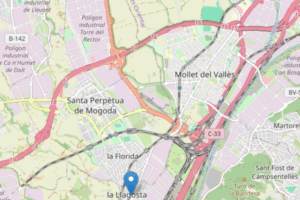
An innovative open data platform for Barcelona
April 29, 2021
A new management model integrated into the water resources of the Besòs
May 10, 2021The research group Analysis and Technology of Structures and Materials (ATEM) is participating in COREWIND, a project that will provide disruptive, profitable solutions for floating offshore wind technology to reduce costs and improve performance and reliability. This objective is achieved by modelling and optimising the concepts of concrete-based floating substructures.
Floating wind turbines could produce electricity further from the coast in deeper waters than traditional turbines that are fixed to the ocean floor, which represent almost all facilities in Europe today. Offshore floating turbines are crucial to obtain energy transition targets. For this to happen, the costs of obtaining this energy must continue to fall. WindEurope estimates that they could be cut to 40–60 €/MWh (currently they stand at over 100 €/MWh) if the right policies were implemented and, especially, if technological innovation comes into play. In this aspect, Corewind will propose solutions that could lead to a reduction in Levelized Cost of Energy (LCOE or the current cost of construction and operating an installation that generates energy during its useful life) of at least 15% in comparison with offshore wind turbines fixed to the seabed.
The reduction in costs of floating wind technology in the open sea could be achieved by optimising two components: mooring and anchorage systems, and the dynamic cables. For this purpose two pilot tests have been carried out in which different solutions have been simulated: the first in front of the Canary Islands (Spain), where the cost savings of mooring systems were estimated to be up to 60%, and the second in Morro Bay (California, USA), whose results showed a potential reduction of up to 55%.

These promising results will enable the door to be opened to the possibility of scaling up two floating technologies: semi-submersible platforms and spar platforms (the name for a design in a vertical position with a float in the upper part and ballast in the lower part), both anchored to the seabed via cables or catenaries.
In addition to the simulations, these improvements will be validated with experimental tests in wave tanks and wind tunnels, taking as a reference the two concepts of concrete floats (semi-submersible and spar) that support large wind generators (15 MW), installed at depths greater than 40 m and at 90 m, respectively. In addition, solutions will be developed and validated to improve the installation techniques and the operation and maintenance activities.
The project will also provide design standards and good practices, as well as open data models to accelerate the development of floating concrete offshore wind turbines. It is expected that the resulting recommendations will facilitate the development of this type of energy, making it a viable technology for intensive use.
COREWIND will take 42 months (2019–2023) and has funding of 5 million euros from the European Union’s Horizon Programme 2020. It is led by the Catalonia Institute for Energy Research (IREC) and a further ten partners in addition to the UPC are involved.

Related Projects
- The company Trace ID and the group Twin Investors, in collaboration with the Textile Technology research group (TECTEX), which is part of the Institute of Textile Research and Industrial Cooperation of Terrassa (INTEXTER) at the Universitat Politècnica de Catalunya - BarcelonaTech (UPC), are developing electronic devices to identify, monitor, and study the traceability of the products in which they are embedded.
- The Hydrogeology Group (GHS) at the Universitat Politècnica de Catalunya - BarcelonaTech (UPC) is participating in the LIFE REMAR project to develop an innovative and sustainable solution for the reuse of treated wastewater through infiltration, with the aim of increasing the availability of freshwater resources and improving the state of ecosystems.
- A team from the Environment Centre Laboratory (LCMA) of the Universitat Politècnica de Catalunya - BarcelonaTech (UPC) is taking part in a study commissioned by the city councils of la Llagosta, Mollet and Santa Perpètua (in Vallès Occidental), with the main objective of identifying the impact of industrial plants on the generation of unpleasant odours and continuously monitoring air quality in these municipalities.
- A multidisciplinary team of researchers from the Research Group in Smart and Sustainable Resources and Industries (RIIS), the Sustainable Mining Research Group (GREMS), and the Construction Materials and Roads (MATCAR) group at the Universitat Politècnica de Catalunya – BarcelonaTech (UPC) is leading the VALORFIN project. The aim is to develop a technological solution for the valorisation of the fine fraction of construction and demolition waste (CDW), transforming it into new low-CO₂-emission cementitious materials, while also reducing the presence of hazardous materials in this waste.




